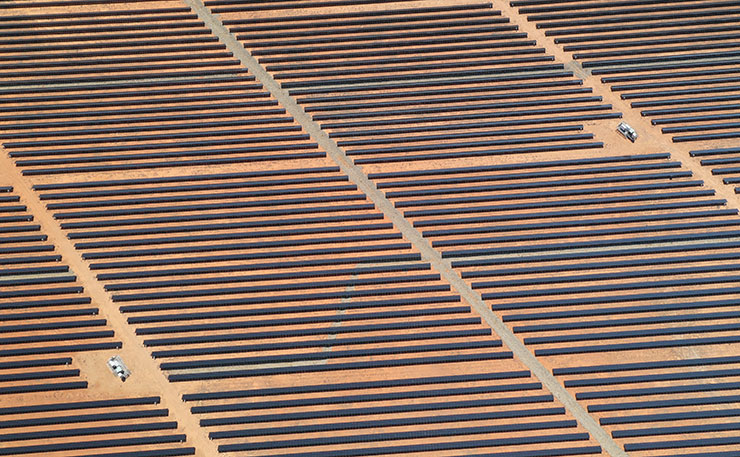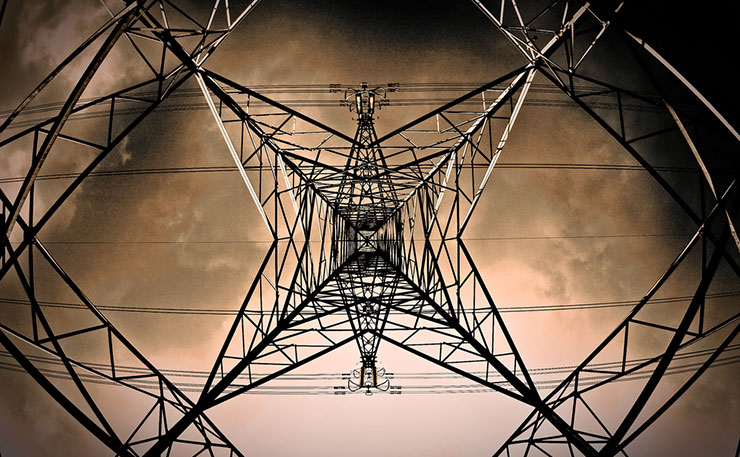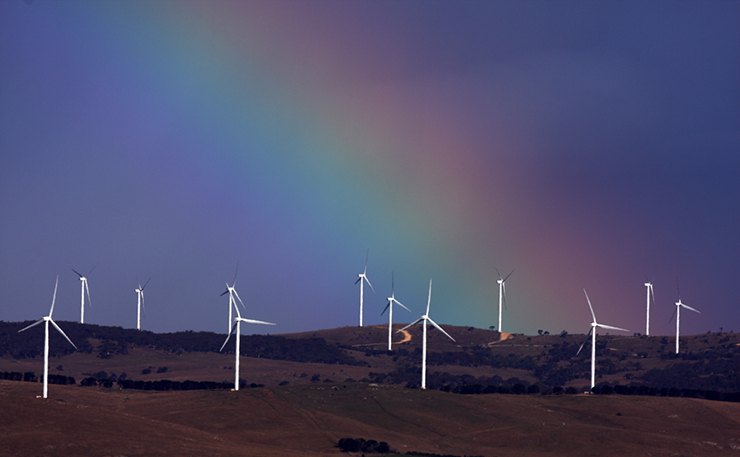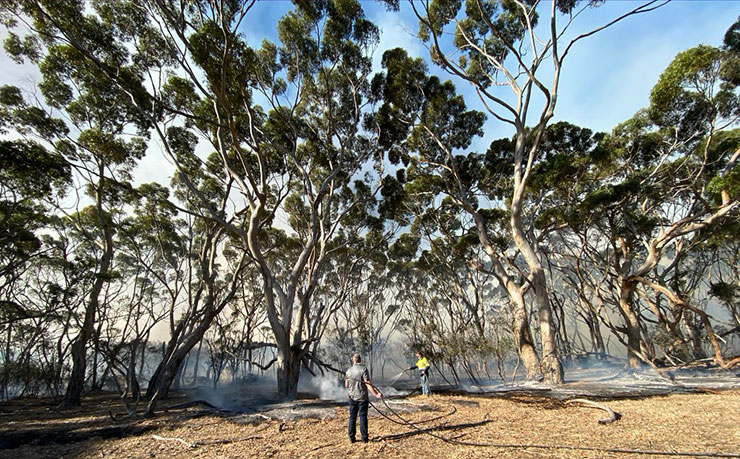DON’T MISS ANYTHING! ONE CLICK TO GET NEW MATILDA DELIVERED DIRECT TO YOUR INBOX, FREE!
Wind, solar and hydro are much safer on the emissions front, but distributing the power they generate brings with it their own unique set of challenges and risks, writes Geoff Russell.
First, a quick note about Adelaide’s flying fox colony, which was the subject of my last NM article. Thousands died during the four days over 40 degrees before Christmas, but about 500 young ones were rescued; they were most likely the only survivors of this year’s birth cohort.
The impacts of subsequent fires on both animals and people has been horrendous, but this is the first time I can remember that animals have been getting a reasonable media mind-share; even if some still use the offensive phrase “stock losses”.
The good news is that the flying foxes taken into care have done remarkably well, with very few deaths. Those in care woke up very quickly to the intentions of their carers and became inquisitive, friendly and thoroughly wonderful critters. All have now been moved into flight aviaries, many built very quickly for the purpose.

Plans are under way for release aviaries – these allow the bats to come and go getting supplementary feeding until they are integrated properly into a colony. Thanks to everybody who supported the Fauna Rescue SA Bat team in this remarkable work.
All over Australia, we have people rescuing everything from snakes to koalas to kangaroos. Watching soldiers in fatigues hand feeding koalas is a remarkable sight; it will change each and every one of them. Dark clouds and silver linings come to mind.
But now back to fires and energy…
Bushfires and Power
Everybody, except perhaps the Prime Minister and several of his colleagues, seems to see the obvious connections between more heat waves and more bushfires. But there is a less obvious connection that is also pretty clear but which will likely be challenging to all kinds of people who think ScoMo is an absolute moron for not admitting the obvious.
How about renewable energy and bushfires? WTF? The connection isn’t between panels and wind turbines catching fire, but the need for vastly more transmission lines to connect up any widely dispersed set of power sources, whether the sources are renewable, nuclear, gas, coal, hydro or biomass.

Power lines are a significant cause of bushfire in Australia. In my state of SA, Wikipedia has details on 10 major bush fire events, power lines were implicated in three of them.
In Australia’s most deadly bushfires, Black Saturday, power lines were the cause of the Kilmore East fire that killed 119 people and injured another 232.
In the US, one power company caused 1,500 fires in California over a period of six years including the 2018 Camp Fire which killed 85 people.
Just before Christmas a class action was settled over the Terang bush fires of 2018, allegedly started by arcing power lines. The Company at the centre of that dispute recently rolled out in the Ararat region what is rather like a very big safety switch to reduce fire risks from arcing power lines in future.
But will those switches be rolled out across Australia? Who knows. Certainly PowerCor are rolling them out in its network. A class action payout does tend to concentrate the mind.
How do power lines cause fires?
There are two major ways. First, wild weather can cause arcing directly by forcing wires together, or can act via trees or tree-limbs and knock them onto power lines causing sparks or arcing. Not clearing a big enough buffer zone around your power lines can see trees simply grow into them.
Second, electrical faults may also cause sparks or arcing. Things just wear out and break. Arcing is like lightning, electrical energy finding a path through the air to a distant point.

Of course, power lines are much more commonly damaged by fires than they are a causal factor in starting them. But fire and even smoke near a transmission line can cause arcing and a subsequent tripping of power switches; meaning that power is cut from the line and people served by the line will lose power.
Air around a power line is normally a great insulator so there is no arcing, but fill that air with heavy smoke and fire and the insulation properties drop and arcing can result.
The word “tripping” makes it sound like you can just flip a switch to turn it on, but it isn’t always that simple. The devices which handle such problems will recognise temporary issues and reconnect the power when the problem clears.
If, for example, a tree limb falls on the line, causes an arc and then falls down, reconnecting the power on the line will typically be automatic. But the tripping could cause significant damage that needs actual fixing by real people; easier said than done in the middle of a fire.
Four methods of risk reduction
There are four ways of reducing the likelihood of a power line causing a fire; just turn it off when there is a big fire risk, clear a bigger area around it, bury it or simply don’t have it at all.
The first option isn’t popular, the third is really expensive, and the fourth is often ignored. So the second option, coupled with better switches is the default option. We’ll come back to option four later.
Our electrical grid is typically thought of in two parts; the big high voltage transmission lines and the smaller lower voltage distribution lines. The transmission lines are high voltage and connect power stations with areas needing power. The distribution grid then fans out to the individual businesses and households.
New land developments are often done with underground power distribution, but undergrounding distribution in existing areas is expensive; $30,000 to $100,000 per residential block.
The total cost to underground the power distribution in SA alone has been estimated at $25 billion. Multiply that up and you’d be looking at something like $400 billion for the whole of Australia.

Putting just your big transmission lines underground costs 10-15 times more than putting them overhead, and the lines only last about 40 years instead of 80. It also takes three to six times longer to actually lay the cables. All of these figures are heavily dependent on terrain and local conditions.
Distributed systems need more transmission lines
Renewable energy systems are highly distributed; meaning they need far longer transmission lines. You put wind farms where the wind is and solar farms where the land is cheap, and where you have road or rail access to deliver the vast tonnages of panels and posts and concrete required.
This makes for a geographic mismatch between where you have electricity and where you need it.
On the 4th of January this year, the transmission lines in the Snowy went down and Victoria and NSW were disconnected; the blackout risks in NSW rose, as did the wholesale price of electricity… hitting over $14,700/MWh.
Events like bushfires need local and reliable power with the shortest possible transmission lines, which isn’t usually wind or solar farms, or hydro.

The mismatch between the location of supply and demand has been evident in SA for some time. South Australia sometimes has more wind power than it can use, so it is building another big transmission interconnector so it can sell that excess power to the eastern states.
In Germany, they need to build about 7,500 kms of new transmission lines over the next few years to move their wind power from the north where their offshore wind farms are, to the south, where their heavy industry is.
Germany doesn’t have our fire regime, but in Australia, every additional kilometre of above ground transmission line through bush, crop or pasture creates additional fire risks that we really don’t need.
Reduce or eliminate transmission lines
The option of minimising transmission lines is something that needs to be part of power system design. How many fires should a transmission line cause before people think about eliminating it in favour of local power generation?
There is only one technology that meets all the requirements for being clean, dispatchable, and reliable. There is an international race between China and the US to be the first to produce small nuclear reactors in factories. A few small power reactors (in addition to a couple of hundred research reactors) are already operating in China, India and Russia; more are under construction in China, Russia and Argentina.
The IEA has added it’s authority to making the obvious perfectly clear; that we can’t beat climate change without nuclear. So it’s time Australia’s Greens got with the science and abandoned their ignorant fear mongering.
We need to start planning now. Small reactors are coming and when they arrive I’m guessing they will come out of China, and come with a rush.
You can put them underground, you can use air cooling, you can power regional centres and big cities without needing transmission lines to connect the two.
It’s every kind of obvious.
BE PART OF THE SOLUTION: WE NEED YOUR HELP TO KEEP NEW MATILDA ALIVE. Click here to chip in through Paypal, or you can click here to access our GoFundMe campaign.
Donate To New Matilda
New Matilda is a small, independent media outlet. We survive through reader contributions, and never losing a lawsuit. If you got something from this article, giving something back helps us to continue speaking truth to power. Every little bit counts.



